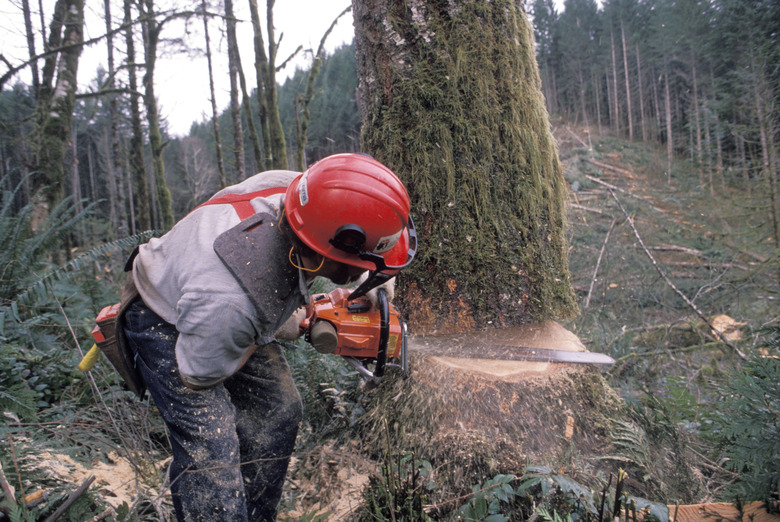How To Fell A Tree In The Desired Direction
Felling a tree — even a small one — isn't a task to be undertaken lightly, because you can be seriously injured or killed if something goes wrong. That said, the methods for making the tree fall in the proper direction are straightforward and depend on which way the tree leans. The most difficult task is getting a tree that leans drastically in one direction to fall in the opposite direction.
Safety First
Before you start cutting the notches to fell a tree, you need to carefully examine its surroundings and plan the direction of the fall. Look overhead to make sure the tree won't get hung up on branches of nearby trees or on power lines. You also need to plan two separate escape routes, and neither should be directly opposite the fall direction — if something goes wrong and the tree kicks back, it will do so in that direction. Remove brush and debris from both routes so you have a clear path.
Draw a Line on the Trunk
The basic felling procedure is to cut a notch on the side of the tree toward the direction you want it to fall, using a chain saw, and then finish cutting through the trunk from the opposite side. The apex of the triangular notch has to be a few inches below the back cut to create a hinge that prevents the trunk from splitting or moving laterally while the tree is falling. The first step in the procedure, therefore, is to paint a horizontal line around the trunk to serve as a reference. It should be about waist high.
Making the Face Cut
The face cut — or notch — consists of two separate cuts; the top cut and the undercut. To make the top cut, hold the saw perpendicular to the trunk, and tilt it so that plane of the bar makes a 70-degree angle with respect to the line on the trunk. The saw should penetrate one-third of the diameter of the trunk when it reaches the line. The undercut is a similar upward cut that makes a 20-degree angle with respect to the line. It's critical that the top cut and undercut meet exactly, and that one does not extend farther than the other — this condition is called a Dutchman, and it can make the trunk split as the tree falls.
Making the Back Cut
The back cut is a horizontal cut that is 2 to 5 inches above the apex of the notch. If the tree is leaning in the direction you want it to fall, it should start falling when the back cut extends about halfway through the trunk. As soon as the tree begins falling, remove the saw and use one of the escape routes to get out of the way. If the tree is leaning in the opposite direction, you need to make the back cut in stages, driving wedges as you go to support the trunk to prevent the saw from binding. Once the back cut extends halfway through the trunk, drive the wedges deeper with a sledgehammer to force the tree in the fall direction.
